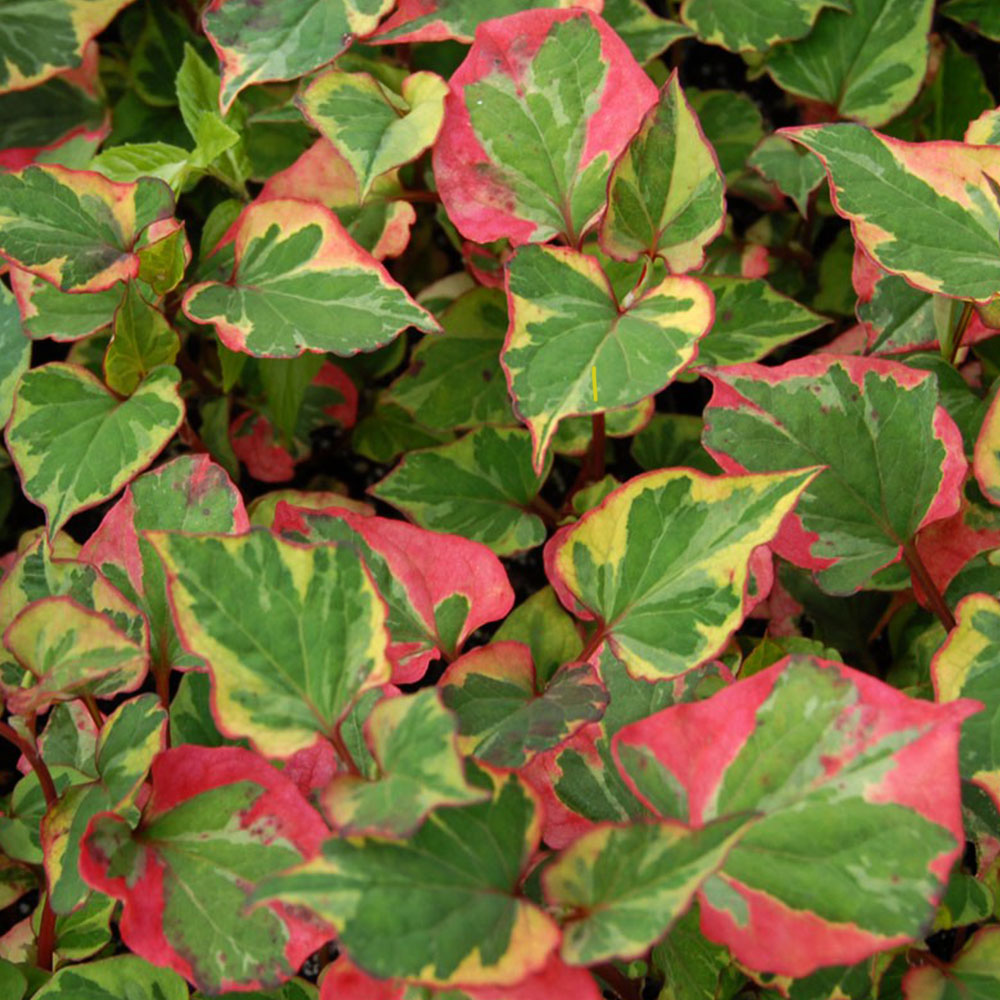No products in the cart.
Houttuynia cordata ‘Chameleon’
A fragrant and ornamental perennial with color-shifting foliage
Rated 0 out of 5
0 customer reviews
6,00 €
Only 18 item(s) left in stock!
SKU: pda322
Category: Balcony-Friendly, Bees and Butterflies, Bouquet, Culinary, Distillations, Fragrant, Frost Hardy, Ground Cover, Medicinal, Rich and Humid

Houttuynia cordata 'Chameleon'
6,00 €
Only 18 item(s) left in stock!
Houttuynia cordata ‘Chameleon’ is a small, ground-covering perennial, known for its attractive, variegated foliage in shades of cream, pink, and green.
The leaves are uniquely fragrant – something between tangerine and sandalwood – and ornamental.
In the spring, the heart-shaped leaves appear on slender stems, displaying a combination of green, cream and pink colors.
In the summer, the leaves redden and the plant produces cone-shaped flowers topped with four large white petals.
The leaves are often used in Asian cooking – check out a few recipes for a salad and a tea down below!
👨🌾 GARDENING TIPS👨🌾:
-
- Hoyttuynia prefer moist, rich and boggy soils and can even tolerate entirely wet areas of the garden
- They spread via its numerous underground rhizomes, and can even become invasive in rich, waterlogged soils.
- Very hardy and easy to grow, it prefers part-shade
- They can become more drought resistant once established, though their super powers lie in the ability to handle high levels of humidity and moisture.
The Tale:
Recipe in English: Fishmint Salad
The Japanese name dokudami comes from an old expression that means to control/suppress poison, reflecting the plant’s long history of remedy use, including detoxification and cleansing wounds of infection as well as treating acne, eczema, burns, insect bites, bee stings, and so on.
While the entire plant is considered effective, leaves, stems and flowers are often dried to make a tea or more concentrated decoction for routine consumption.
The tea is considered a diuretic in Japan = How to Make Chameleon Tea
Other names
Fish mint
Chinese pepper
Lizard tail
Dokudami
Herbe-à-poivre
Coriandre des bois
Origin:
Europe
| Weight | 0,5 kg |
|---|---|
| Flower Color | ⚪ White |
| Flowering | June, July |
| Exposure | Half Sun/Half Shade |
| Frost Tolerance | -25°C to -30°C |
| Soil | Aquatic, Cool, Clay, Moist |
| Size | 0.45m H x 0.45m W |
Reviews
0
Rated 0 out of 5
0 customer reviews
5
0
4
0
3
0
2
0
1
0
Only logged in customers who have purchased this product may leave a review.
You may also like…
Vinca major Variegata
Vinca major Variegata is a trailing vine with a magnificent color variegation, spreading along the ground to form dense masses of groundcover, come sun, come shade.
Vinca major Variegata is a trailing vine with a magnificent color variegation, spreading along the ground to form dense masses of groundcover, come sun, come shade.
Rated 0 out of 5
Vinca minor
Looping elegance and ability to form a low flowering ground cover
Looping elegance and ability to form a low flowering ground cover
Rated 0 out of 5
Vinca major
A trailing vine, spreading along the ground to form dense masses of groundcover, come sun, come shade.
A trailing vine, spreading along the ground to form dense masses of groundcover, come sun, come shade.
Rated 0 out of 5
Related Products
Tanacetum densum subsp amani
A shrublet composed of soft, finely divided silvery gray-white leaves.
A shrublet composed of soft, finely divided silvery gray-white leaves.
Rated 0 out of 5
Euphorbia cyparissias Clarice Howard
A Euphorbia that resembles a soft little cyprus tree
A Euphorbia that resembles a soft little cyprus tree
Rated 0 out of 5
Hellebore argutifolius
Winter flowering perennial with marbled blue-green leaves
Winter flowering perennial with marbled blue-green leaves
Rated 0 out of 5
Kalanchoe daigremontiana
A toothy succulent from Madagascar, known as the Mother of Thousands.
A toothy succulent from Madagascar, known as the Mother of Thousands.
Rated 0 out of 5
Delosperma cooperi
A dwarf perennial known for its vermillion colored flowers
A dwarf perennial known for its vermillion colored flowers
Rated 0 out of 5
Cerastium tomentosum var. columnae
A grey-green spreading ground cover from the mountains.
A grey-green spreading ground cover from the mountains.
Rated 0 out of 5
Glechoma hederacea
A sweet smelling ground cover, producing little blue flowers all summer long.
A sweet smelling ground cover, producing little blue flowers all summer long.
Rated 0 out of 5
Sedum album
A low, multi-color ground cover.
A low, multi-color ground cover.
Rated 0 out of 5
Hieracium maculatum Leopard
A native perennial with blue-green leaves and a tall yellow flower
A native perennial with blue-green leaves and a tall yellow flower
Rated 0 out of 5
Erigeron kavinskianus
A daisy-like carpet of flowers
A daisy-like carpet of flowers
Rated 0 out of 5
Trachelospermum asiaticum ‘Ogon Nishiki’
Jasmine with colorful foliage and lovely white flowers in summer
Jasmine with colorful foliage and lovely white flowers in summer
Rated 0 out of 5
Euphorbia myrsinites
Known for its draping form of silver-gray foliage and radiant blooms.
Known for its draping form of silver-gray foliage and radiant blooms.
Rated 0 out of 5
Stachys byzantina
Silky white-grey leaves and tall striking flowers
Silky white-grey leaves and tall striking flowers
Rated 0 out of 5
Melissa officinalis
A perennial plant in the mint family that is adored by bees, royal families and tea drinkers.
A perennial plant in the mint family that is adored by bees, royal families and tea drinkers.
Rated 0 out of 5
Tradescantia Blushing Bride
Gorgeous blushes of pink and white that appear in the coldest nights.
Gorgeous blushes of pink and white that appear in the coldest nights.
Rated 0 out of 5
Artemisia Valerie Finnis
A semi-evergreen, aromatic variation on the theme of Artemisia.
A semi-evergreen, aromatic variation on the theme of Artemisia.
Rated 0 out of 5
Potentilla anserina
A distinctly silvery, silky and lacy perennial.
A distinctly silvery, silky and lacy perennial.
Rated 0 out of 5
Echinacea purpurea
A perennial with purple flowers all summer long
A perennial with purple flowers all summer long
Rated 0 out of 5
recent view product
Sedum spectabile Variegatum
Luminous variegated leaves and soft white flowers
Luminous variegated leaves and soft white flowers
Rated 0 out of 5
Veronica peduncularis Georgia Blue
A gorgeous creeping perennial that creates a dense carpet of bright blue flowers.
A gorgeous creeping perennial that creates a dense carpet of bright blue flowers.
Rated 0 out of 5
Achillea millefolium Summer Pastels
A tall flowering perennial known for its soft pastel colors
A tall flowering perennial known for its soft pastel colors
Rated 0 out of 5
Billbergia nutans
A bromeliad featuring a three colored, striped flower
A bromeliad featuring a three colored, striped flower
Rated 0 out of 5
Chamaemelum nobile
A perennial with bright daisy-like flowers, known for flavoring teas and syrups.
A perennial with bright daisy-like flowers, known for flavoring teas and syrups.
Rated 0 out of 5


















































There are no reviews yet.